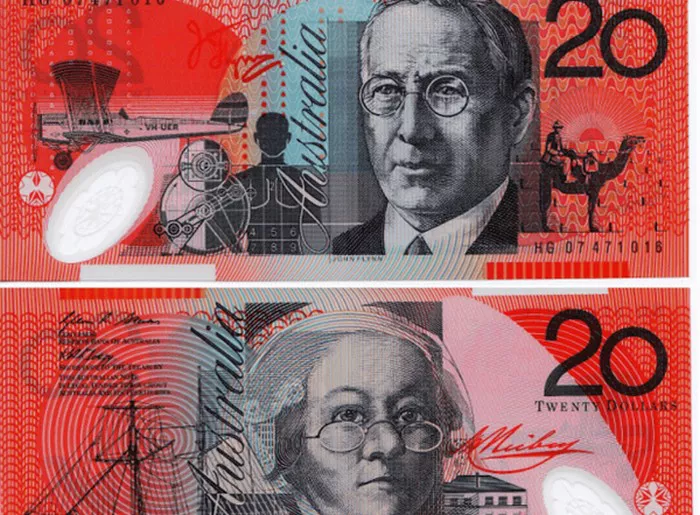Australia, known for its vibrant landscapes and diverse culture, boasts a unique and visually striking currency that reflects the nation’s identity. The Australian currency is not only a medium of exchange but also a canvas that showcases the country’s rich history, indigenous heritage, and natural beauty. In this article, we will delve into the intricacies of what Australian currency looks like, exploring the design elements, security features, and the cultural significance embedded in each note and coin.
Design Elements:
Australian banknotes and coins are renowned for their innovative design elements that blend tradition with modernity. The Australian dollar (AUD) banknotes come in denominations of $5, $10, $20, $50, and $100. Each note features a distinct color scheme and design, making it easy to differentiate between denominations.
One of the notable features of Australian banknotes is the use of polymer material. Introduced in 1988, the polymer banknotes are durable, resistant to wear and tear, and incorporate advanced security features. The tactile nature of polymer banknotes allows for enhanced durability, ensuring a longer circulation life compared to traditional paper banknotes.
The obverse side of each banknote typically features a prominent portrait of an Australian historical figure. For instance, the current $5 note showcases Queen Elizabeth II and Parliament House, symbolizing the political heritage of Australia. The reverse side of the note portrays representations of native Australian flora and fauna. The $10 note highlights Dame Mary Gilmore and Banjo Paterson, both iconic Australian poets, with illustrations of native cockatoos and wattle flowers.
Moving up the denominations, the $20 note celebrates the renowned soprano Dame Nellie Melba and engineer Sir John Monash. The reverse features depictions of the lyrebird and waratah flowers, emphasizing Australia’s cultural and natural diversity. The $50 note showcases Aboriginal writer and inventor David Unaipon and the first female member of an Australian parliament, Edith Cowan, alongside images of an orb and dividers, symbolizing knowledge and technology.
The highest denomination, the $100 note, features the distinguished medical researcher Sir Howard Florey and the celebrated soprano Dame Nellie Melba. The reverse includes depictions of the Australian golden wattle and the feathertail glider, highlighting Australia’s unique flora and fauna.
Security Features:
Australian currency is equipped with advanced security features to deter counterfeiting and ensure the integrity of the financial system. Polymer banknotes incorporate a range of security measures, such as transparent windows, holographic features, and microprinting. These elements are designed to be visually striking and difficult to replicate, ensuring the authenticity of the currency.
In addition to these visual elements, there are also tactile features, such as raised printing, that aid the visually impaired in distinguishing between different denominations. The inclusion of Braille dots on certain banknotes further enhances accessibility for individuals with visual impairments, aligning with Australia’s commitment to inclusivity.
Coins, too, are not exempt from security measures. Australian coins feature intricate designs, and certain denominations include microprinting and serrated edges to prevent counterfeiting. The Royal Australian Mint, responsible for coin production, continually explores cutting-edge technologies to enhance the security features of coins while maintaining their aesthetic appeal.
See Also: What is the best time to trade AUD/USD?A Closer Look
Cultural Significance:
Australian currency goes beyond its utilitarian purpose; it serves as a canvas reflecting the nation’s cultural diversity, historical achievements, and indigenous heritage. The inclusion of prominent figures from various fields, such as literature, science, and politics, pays homage to the contributions of individuals who have shaped Australia’s identity.
The representation of Aboriginal and Torres Strait Islander people on Australian banknotes acknowledges the rich indigenous history of the land. The $50 note, for example, features David Unaipon, an Aboriginal writer and inventor, celebrating the cultural and intellectual contributions of Australia’s First Nations people. This intentional inclusion promotes cultural awareness and recognition of the nation’s diverse heritage.
Moreover, the depictions of native flora and fauna on banknotes emphasize Australia’s unique natural environment. From the iconic kangaroo and koala to the lesser-known feathertail glider and waratah flowers, each element is carefully chosen to showcase the country’s biodiversity. This representation not only instills a sense of national pride but also raises awareness about the importance of conservation.
Conclusion:
In conclusion, the Australian currency stands as a testament to the nation’s commitment to innovation, inclusivity, and cultural appreciation. The unique combination of polymer banknotes, advanced security features, and culturally significant designs sets Australian currency apart on the global stage. Beyond its utilitarian function, each note and coin serves as a visual narrative, telling the story of Australia’s history, values, and natural beauty. As we continue to embrace technological advancements, the Australian currency remains a tangible expression of the country’s identity and heritage.


